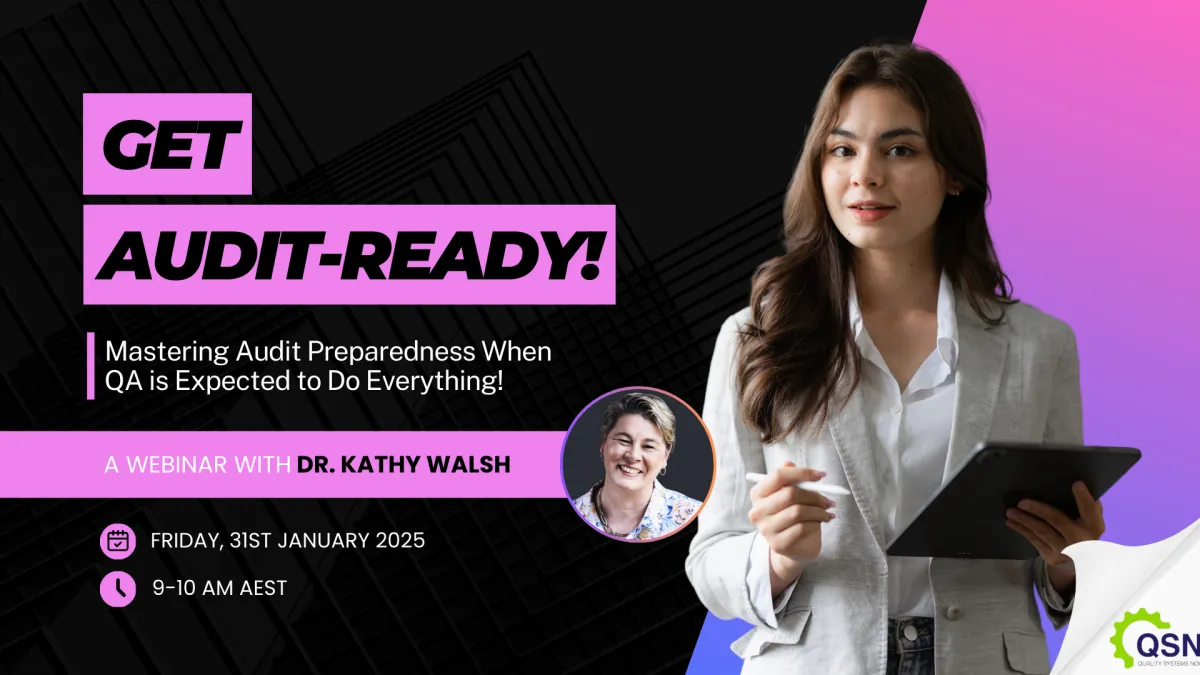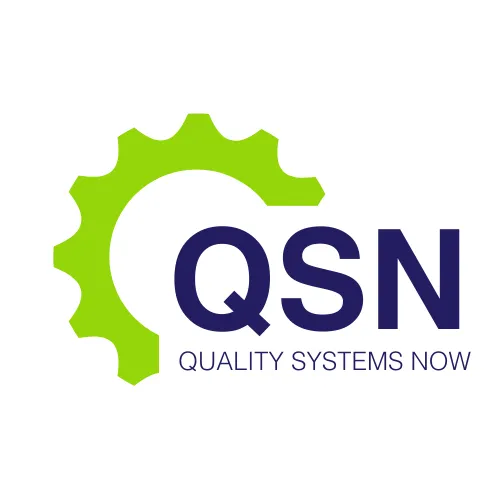LATEST NEWS

Free Get Audit Preparedness Webinar This Week
Get Audit Ready: Mastering Compliance Strategies for Pharma, Medical Device, and Biotech Professionals
Join us for an insightful webinar focused on actionable strategies to help your team tackle the challenges of audit preparedness. Designed for pharma, medical device, and biotech professionals, this session is a must-attend for anyone feeling the pressure of upcoming regulatory audits.
Webinar Details: Topic: Get Audit Ready - Mastering Audit Preparedness When QA is Expected to Do Everything
Date: Friday, January 31, 2025
Time: 9:00 AM - 10:00 AM AEST
Location: Online (Register Now)
In this session, you'll gain practical tools and techniques to:
✔ Close compliance gaps before inspectors arrive.
✔ Engage your entire organization in audit readiness.
✔ Align audit preparation with operational excellence and LEAN principles.
Spaces are limited, so don't miss out—register today before it's too late!
Regulatory audits serve as a mechanism to ensure that pharmaceutical, medical device, and biotech companies are complying with the necessary standards set by regulatory bodies. These audits assess everything from manufacturing practices and quality assurance (QA) systems to data integrity and documentation. For companies in these industries, audits are not only a regulatory requirement but also an opportunity to demonstrate the robustness of their processes and their commitment to product quality and safety.
When an audit is scheduled, the quality assurance (QA) team typically shoulders the responsibility of ensuring the entire organization is audit-ready. Given the complexities involved, it is essential for the team to be fully prepared and equipped with strategies that can help them handle the scrutiny of inspectors while minimizing disruption to day-to-day operations.
Closing Compliance Gaps Before the Inspectors Arrive
The first step in audit preparedness is identifying and closing compliance gaps well before the auditor arrives on-site. It is common for organizations to become complacent, believing that they have everything under control until the audit date looms closer. However, waiting until the last minute to address any issues can lead to unnecessary stress and potentially negative outcomes.
Here are a few key steps to ensure you're closing compliance gaps:
Perform Internal Audits: Regular internal audits can help identify compliance gaps and areas that require improvement before they become an issue during an official audit. Internal audits should be thorough, covering every aspect of your operations, from quality systems to documentation practices.
Review Documentation and Records: Accurate and up-to-date documentation is crucial for a successful audit. Make sure that all records—whether they relate to product development, manufacturing processes, or quality control—are readily accessible and in full compliance with the applicable regulatory standards.
Conduct Mock Audits: Simulate the audit process with your internal team. By running mock audits, you can create a realistic practice environment that will allow you to address any deficiencies or weaknesses in your preparation.
Address Non-Conformances Early: If your internal audits or reviews uncover any non-conformances, address them immediately. These might be minor, such as outdated forms, or more significant issues like improper documentation procedures. Resolving non-conformities early prevents them from escalating and becoming serious compliance risks.
Engaging Your Organization at Every Level in Audit Readiness
Audit preparedness should not rest solely on the shoulders of the QA team. Successful audits require the involvement and engagement of all departments across the organization. From R&D to manufacturing, every division plays a vital role in ensuring compliance, and each individual within the organization should understand their responsibility when it comes to audit readiness.
Here’s how to engage your entire organization:
Promote Awareness: One of the biggest challenges in audit readiness is a lack of awareness among staff. Ensure that employees at every level understand the importance of audits and their role in the process. Conduct training sessions to educate staff about audit procedures, compliance requirements, and the documentation standards they need to uphold.
Develop Cross-Functional Teams: Audit preparation should be a collaborative effort across departments. Create cross-functional teams that bring together representatives from different areas of the organization. By collaborating, teams can address potential issues from multiple perspectives and ensure that the organization is prepared on all fronts.
Simulate Real-World Scenarios: Engage employees in realistic audit simulations. This will help them understand the expectations of auditors and how to handle questions, document requests, and other audit scenarios. It also fosters confidence and reduces the likelihood of errors during the actual audit.
Maintain a Culture of Compliance: To ensure audit readiness becomes part of the company’s DNA, it’s essential to foster a culture of compliance. Regularly reinforce the importance of maintaining high standards, and celebrate compliance successes to keep the focus on continuous improvement.
Connecting Audit Preparation to Operational Excellence and LEAN Practices
Audit readiness and operational excellence go hand-in-hand. Companies that integrate audit preparation into their overall operational strategy are better positioned for success. Moreover, the LEAN methodology—which focuses on eliminating waste, improving processes, and ensuring efficiency—can be a powerful tool in audit readiness.
Here’s how to connect audit preparation with operational excellence and LEAN principles:
Streamline Processes for Efficiency: LEAN principles focus on reducing inefficiencies in processes. By applying LEAN to your audit prep, you can simplify documentation processes, improve data collection practices, and create standardized workflows that reduce the likelihood of errors during audits.
Focus on Continuous Improvement: A LEAN-driven approach to audit readiness encourages continuous improvement. Rather than waiting for an audit to highlight deficiencies, companies should strive for ongoing process optimization and compliance throughout the year. By making compliance a continuous objective, you’ll ensure your operations remain audit-ready at all times.
Implement Standardized Workflows: Developing and maintaining standardized processes ensures consistency and reduces the potential for errors. Standard Operating Procedures (SOPs) and workflows should be regularly updated to reflect changes in regulatory requirements and operational best practices.
Monitor Key Performance Indicators (KPIs): Monitoring KPIs, particularly those related to quality control and compliance, allows you to measure performance against audit requirements. These metrics offer valuable insights into potential areas of improvement and provide a real-time view of how well your organization is prepared for audits.
Confidence and Readiness for Any Audit
Audit preparedness is an ongoing commitment that requires collaboration, strategy, and attention to detail. By taking a proactive approach to closing compliance gaps, engaging your team at every level, and aligning your audit preparation with operational excellence and LEAN practices, you will ensure that your organization is not only ready for its next audit but is continuously improving in ways that contribute to long-term success.
In an environment where regulatory audits are inevitable, mastering audit readiness is a critical skill. With these strategies in hand, you’ll be equipped to handle the demands of any inspection, reduce the stress of the process, and ultimately demonstrate your organization’s commitment to compliance, quality, and operational excellence.
